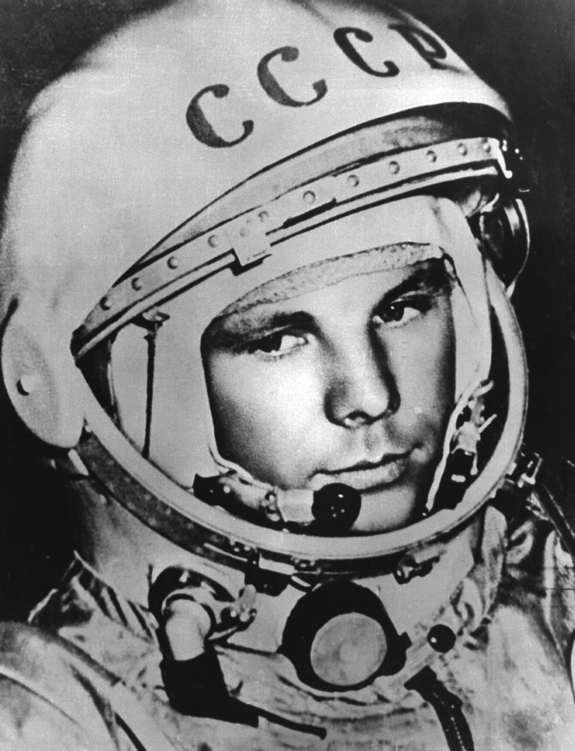6 Surprising Facts About the First Manned Space Mission

Fifty years ago, on April 12, 1961, Russian cosmonaut Yuri Gagarin became the first person in space. The rocket carrying Gagarin's Vostok 1 spacecraft launched from Baikonur Cosmodrome at 6:07 a.m. local time. Reaching unprecedented speeds for manned travel, the spacecraft broke free of the Earth's gravitational pull and entered orbit around the planet, circling once before re-entering the atmosphere and landing back on Soviet soil.
Here are six little-known facts about Gagarin's historic mission.
How long was Gagarin up there?
The total mission lasted just 108 minutes, and the trip once around the Earth at 17,500 mph (most of the way) took less than an hour and a half. In that time, Vostok 1 completed one not-quite-circular orbit, at a maximum altitude of 203 miles, before slowing down to the point that the capsule was pulled back into the atmosphere for ballistic reentry.
What kind of vessel was the Vostok 1?
The Vostok was a spherical capsule, designed to eliminate changes in center of gravity . In that way, the craft could assure comfort for its one-man crew no matter its orientation. What it wasn't designed to do was land with a human still on board.
Unlike later Russian space vehicles, such as the modern Soyuz capsule , Vostok 1 was not outfitted with thrusters to help slow it down as it headed back toward Earth, so Gagarin had to eject before reaching ground, at an altitude of around four miles.
Sign up for the Live Science daily newsletter now
Get the world’s most fascinating discoveries delivered straight to your inbox.
But since the achievement would not have been regarded as the first successful manned mission to space unless it included a manned landing, the Russians kept this little detail out of official press releases.
What prevented earlier missions from reaching orbit?
In a word: speed. In order to escape Earth's gravitational pull, a ship needs to hit 17,500 mph, or about 5 miles per second. Before the Vostok 1 mission, no rocket was powerful enough to get a vessel going that fast. The Vostok capsule's cannonball shape helped the rocket and spacecraft reach the necessary velocity.
How did they test the Vostok before Gagarin's mission?
A few weeks prior, a prototype of Gagarin's craft, the Vostok 3KA-2, completed one low-Earth orbit carrying a life-size dummy named Ivan Ivanovich and a dog called Zvezdochk. Ivan was sold in a Sotheby's auction in 1993.
Who was Yuri Gagarin?
Yuri Gagarin was a 27-year-old Soviet Air Force pilot when he made his first and only trip into space. Upon his triumphant return he instantly became a national treasure, too valuable to send on such a dangerous mission again.
It's a sad irony, then, that when he was finally scheduled to ascend to the cosmos once more, he died in a crash during a routine training exercise. Gagarin remained a hero after the fall of the Soviet Union; statues of him were preserved while monuments to Russia's Communist leaders were torn down.
Modern cosmonauts still observe a sacred launch-day tradition based on Gagarin's preflight preparations in 1961. On the way to the launch pad, the bus carrying the crew stops so that the members can hop out and "take a leak ," just as Gagarin did the morning he made history.
Launch pad still in use
One lasting legacy of Gagarin's historic spaceflight is the mission's launch pad at Baikonur Cosmodrome. The launch pad is still in use today with the latest crew of the International Space Station blasting off from the site last week on April 5 local time (late April 4 EDT).
Baikonur Cosmodrome is one of several launching sites used by Russia's Federal Space Agency (also known as Roscosmos), but it is not in Russia. The launch site is in Kazakhstan, a country that was part of the Soviet Union during the Cold War but is now a separate nation.
Cosmonauts continued launching from Gagarin's Vostok 1 pad throughout the Cold War, and the tradition continues to this day.
- What Exactly Is a 'Sputnik Moment'?
- Slideshow: 6 Everyday Things that Happen Strangely In Space
- What's It Like to Live In Space?
Got a question? Send us an emailThis e-mail address is being protected from spambots. You need JavaScript enabled to view it This e-mail address is being protected from spambots. You need JavaScript enabled to view it This e-mail address is being protected from spambots. You need JavaScript enabled to view it This e-mail address is being protected from spambots. You need JavaScript enabled to view it This e-mail address is being protected from spambots. You need JavaScript enabled to view it This e-mail address is being protected from spambots. You need JavaScript enabled to view it This e-mail address is being protected from spambots. You need JavaScript enabled to view it This e-mail address is being protected from spambots. You need JavaScript enabled to view it This e-mail address is being protected from spambots. You need JavaScript enabled to view it This e-mail address is being protected from spambots. You need JavaScript enabled to view it This e-mail address is being protected from spambots. You need JavaScript enabled to view it This e-mail address is being protected from spambots. You need JavaScript enabled to view it This e-mail address is being protected from spambots. You need JavaScript enabled to view it This e-mail address is being protected from spambots. You need JavaScript enabled to view it This e-mail address is being protected from spambots. You need JavaScript enabled to view it This e-mail address is being protected from spambots. You need JavaScript enabled to view it and we'll crack itThis e-mail address is being protected from spambots. You need JavaScript enabled to view it .









